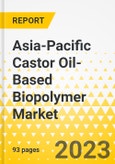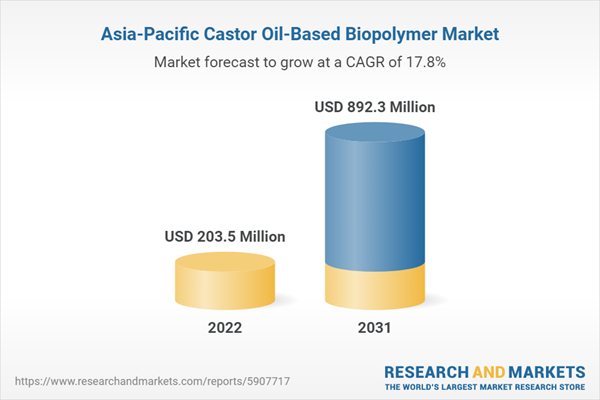10% Free customization
The Asia-Pacific castor oil-based biopolymer market (excluding China) is projected to reach $892.3 million by 2031 from $203.5 million in 2022, growing at a CAGR of 17.8% during the forecast period 2022-2031. The growing demand for bio-polyamides, the growing acceptance of high-performance bio-polyamides, and the expanding use of sustainable biopolymers are expected to propel the APAC castor oil-based biopolymer market's considerable growth in the upcoming years. Castor oil-based biopolymers' sophisticated properties are anticipated to support market expansion as well. However, the high cost of biopolymers based on castor oil, the price volatility of raw materials, and the reliance on India as a key source of castor seeds could potentially hinder the growth of this market in the near future. This report comes with 10% free customization, enabling you to add data that meets your specific business needs.
Market Introduction
The growing demand for sustainable biopolymer solutions, favorable government regulations, expanding research and development efforts, and the adoption of biopolymers across a range of industries are all expected to contribute to the APAC castor oil-based biopolymer market's projected significant growth in the upcoming years. Significant breakthroughs and innovations are anticipated in the market, which will accelerate its growth trajectory.Market Segmentation:
Segmentation 1: by End User
- Automotive
- Solar
- Household Appliances
- Textile
- Oil and Gas
- Others
Segmentation 2: by Polymer Type
- Bio-Polyamides
- Bio-Polyamide 6
- Bio-Polyamide 10 and 11
- Bio-Polyurethane
- Others
Segmentation 3: by Form
- Pellets
- Yarns
- Others
Segmentation 4: by Country
- Japan
- South Korea
- India
- Rest-of-Asia-Pacific
How can this report add value to an organization?
Product/Innovation Strategy: The product segment helps the reader understand the different polymer types involved in the production of castor oil-based biopolymers, such as bio-polyamides, bio-polyurethane, and others. Moreover, the study provides the reader with a detailed understanding of the Asia-Pacific castor oil-based biopolymer market based on the end user (automotive, solar, household appliances, oil and gas, textile, and others). Castor oil-based biopolymers are gaining traction in end-user industries on the back of sustainability concerns and their excellent properties, such as lightweight, toughness, and chemical and abrasion resistance.Growth/Marketing Strategy: The Asia-Pacific castor oil-based biopolymer market has seen major development by key players operating in the market, such as the establishment of new production facilities, product development, mergers and acquisitions, and strategic joint ventures to strengthen their position in the Asia-Pacific castor oil-based biopolymer market.
Competitive Strategy: Key players in the Asia-Pacific castor oil-based biopolymer market analyzed and profiled in the study involve castor oil-based biopolymer manufacturers and the overall ecosystem. Moreover, a detailed competitive benchmarking of the players operating in the Asia-Pacific castor oil-based biopolymer market has been done to help the reader understand how players stack against each other, presenting a clear market landscape. Additionally, comprehensive competitive strategies such as agreements, partnerships, acquisitions, and collaborations will aid the reader in understanding the untapped revenue pockets in the market.
Key Market Players and Competition Synopsis
The companies that are profiled have been selected based on inputs gathered from primary experts and analysing company coverage, product portfolio, and market penetration.Some of the prominent names established in this market are:
- Toray Industries, Inc.
- UNITIKA LTD.
- Mitsui Chemicals Inc.
- Asahi Kasei Corporation
This product will be delivered within 3-5 business days.
Table of Contents
1 Markets
2 Regions
3 Markets - Competitive Benchmarking & Company Profiles
List of Figures
List of Tables
Executive Summary
The Asia-Pacific castor oil-based biopolymer market (excluding China) is estimated to reach $892.3 million by 2031, reveals the premium market intelligence study. The study also highlights that the market is set to witness a CAGR of 17.8% during the forecast period 2022-2031.The region comprises Japan, South Korea, India, and Rest-of-Asia-Pacific. The demand for castor oil-based biopolymers is anticipated to increase due to the rising demand for sustainable solutions across the region. Another major reason contributing to the growth of the market is the sustainability and recovery of the economy by the countries during the post-pandemic period.
The Asia-Pacific Castor Oil-Based Biopolymer Market: Drivers and Challenges
Asia-Pacific is one of the major regions for the production and sales of automotives. The ongoing investments by several automotive manufacturers in different regional countries are further expected to drive the demand for castor oil-based biopolymers.Some of the countries in Asia-Pacific are still in their developing phase, and sustainability is not a priority for many of the regional countries. Further availability of several bio-based plastics at an economical price range, along with easy availability of other bioplastics, including naturally occurring fibers such as soy and hemp strengthen polymers, may hinder the adoption of castor oil based biopolymers over the forecast period.
USPs of report
- Analysis of business drivers and challenges of the Asia-Pacific Castor Oil-Based Biopolymer Market
- Detailed analysis of Castor Oil-Based Biopolymer Market for South Korea, India, and Japan
- Extensive competitive benchmarking of key players to offer a holistic view of the global castor oil-based biopolymer market landscape
Market segregation based on polymer type, form, and end user
Analyst’s Perspective on Asia-Pacific Castor Oil-Based Biopolymer Market
The Principal Analyst states, 'Castor oil-based biopolymers play a significant role in automotive, textile, household appliances as well as other applications. Castor oil-based biopolymers have been adopted by these end users as they enhance the aesthetics, durability, chemical and abrasion resistance, and longevity of the substrates to which they are applied. Also, the expansion of the automotive industry, growing sustainable textiles industry, along with the demand from household appliances are anticipated to drive market growth over the forecast period.'Key Questions Answered in the Report
- What are the major factors and trends that are impacting the consumption of castor oil-based biopolymers?
- What are some of the key initiatives taken by the existing players to improve their market positioning and strategies adopted by new players entering in market space?
- What is the market's leading product and most promising application, and how it would emerge in the coming years?
Companies Mentioned
- Toray Industries, Inc.
- UNITIKA LTD.
- Mitsui Chemicals Inc.
- Asahi Kasei Corporation
Table Information
| Report Attribute | Details |
|---|---|
| No. of Pages | 93 |
| Published | November 2023 |
| Forecast Period | 2022 - 2031 |
| Estimated Market Value ( USD | $ 203.5 Million |
| Forecasted Market Value ( USD | $ 892.3 Million |
| Compound Annual Growth Rate | 17.8% |
| Regions Covered | Asia Pacific |
| No. of Companies Mentioned | 4 |









